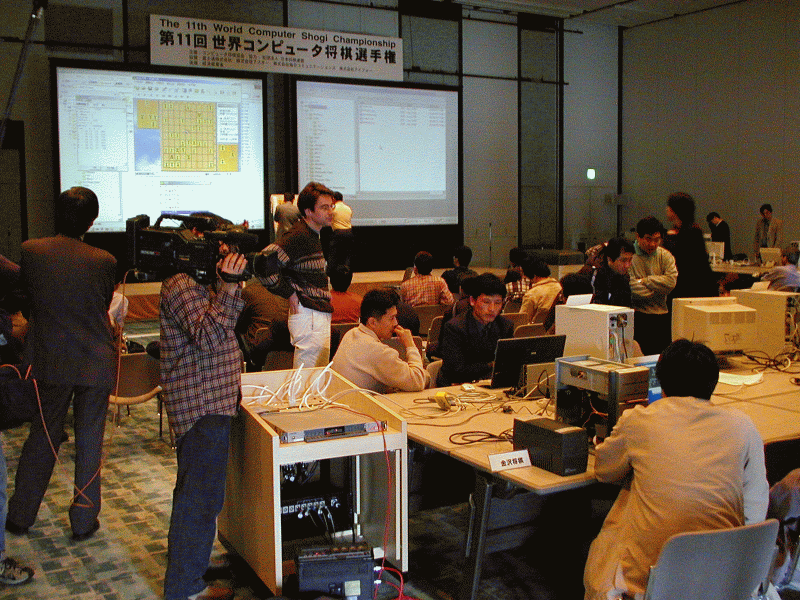
The Tournament Hall
The CSA tournament finally broke the magic number of 50 participants this year. This time there were 55 programs trying their luck. Also, the CSA tournament finally had the confidence to call itself the World Computer Shogi Championships. Of course, everyone already knew that the tournament had this status, as it is the only computer shogi tournament, but for the first time this year it was also billed as such. As for the "World" part: this year there were exactly the same non-Japanese participants as last year: Jeff Rollason's Shotest from England, Pauli Misikangas' Shocky from Finland, KCC Shogi from North Korea and my program Spear from The Netherlands (even though I have lived in Japan for a long time). This year, KCC Shogi was the center of attention. There was a camera crew of Japan's top news program from the Asahi television station following both KCC Shogi and IS Shogi (the winner last year), hoping for a Japanese-Korean showdown in the finals. The North Koreans had come to the tournament with a big delegation. In previous years, there were only two Japanese operators, but this time the main programmers and some company officials had also made the trip to Kisarazu. Of course, they needed to clear the preliminary stage first to get a shot a the championship, something KCC Shogi failed to do last year.
The tournament system had changed only slightly compared to last year's tournament. There were still three stages: eight programs would qualify from the first preliminary tournament to the second preliminary tournament. This second preliminary tournament would have 24 programs. Last year from this second preliminary tournament five programs qualified for the finals, with three programs seeded from the year before. This year the finals would be a tournament of 10 programs, so 7 programs would qualify for the finals from the second preliminary tournament. Also, the time limits for each game were 25 minutes (minimum 1 second per move) for all tournament stages.

The Tournament Hall
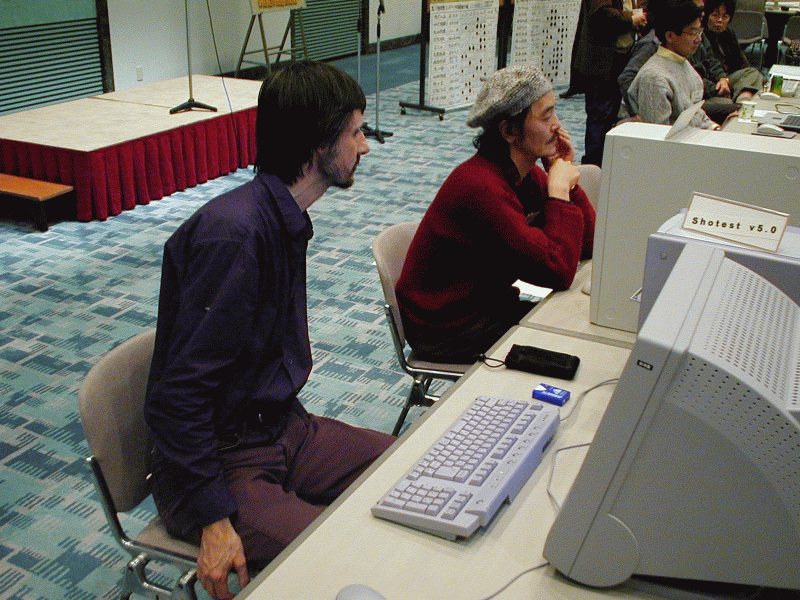
Jeff's Shotest playing Tancho. The deciding game?
My fears became reality in the first two rounds of the tournament. First Spear messed up the opening against Shogi Moba, but this program was too weak to follow this up and despite some anxious moments, Spear won quite quickly in the end. Worse was what happened in the second round. Sekushii Aichan is the program of the students of the lab of professor Kotani and this program has participated in this tournament before. Again Spear got into an opening build-up it didn't recognize and it played a completely wrong opening strategy. Unlike the first round opponent, Aichan followed this with a strong attack and when a terrible bug in my program cost Spear a major piece and time, Aichan had a completely won position. I could hardly bare to look as for several moves as there was a simple and very quick win. Simple for humans, but not for computers as it turned out. Aichan let Spear escape and under time pressure didn't see a simple mating threat (the game had already turned around by then), which abruptly ended the game in Spear's favor.
There went my carefully built-up confidence, but I had two wins to hide my embarrassment. It seemed that the shogi Gods thought that I had suffered enough after this, as the next two rounds brought good wins against the Amano family. I first beat the program of the son ( Amano Sofu) and then the program of the father ( Amano Shogi). I'm afraid I am not welcome for dinner at the home of the Amano's anymore. These wins put me at the top of the table with Yano Shogi and Hyper Shogi and meant that I needed only one win from the remaining three games to qualify for the next round. This win would not come in the fifth round, as I lost against Yano Shogi. Interestingly, Spear found a bug in Yano Shogi: it would not avoid repetition of moves (which is a draw in computer shogi). Unfortunately, Spear was programmed to avoid this if possible, as a draw would almost never be a desirable result in this qualification round. I had forgotten to reset the parameter to avoid draws before the game against Yano Shogi. When both programs didn't know how to continue and started moving around pieces aimlessly, Spear finally got over an evaluation threshold and opened the game at a very bad time. Yano Shogi was quick to take advantage and steamrolled over Spear's position after that.
Still one more game to win and my next opponent also didn't look easy. S1.6 is the program of the students of the lab of professor Noshita and one of the veteran program in the CSA tournament (it even played in the finals a couple of years back). Furthermore, I had lost against this program last year because of a programming bug. Surprisingly, this game went very smoothly. I was quite lucky that a strange opening this time worked in Spear's favor. My program is not programmed to play quick attacks, but in this game it was more or less forced in one as its bad castle could not be improved (this is the main priority in the opening). The attack went perfectly and Spear got an overwhelming position. S1.6 struggled for a long time after that, but never got a chance to get back in the game. This win was a great relief, as this meant qualification for the second round despite all the problems that my program had, especially in the second round against Sekushii Aichan.
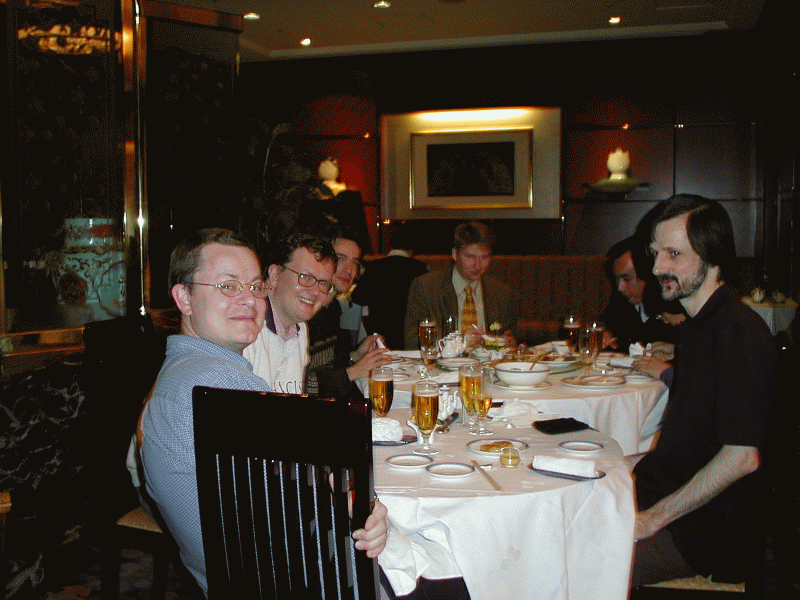
Some time to relax? From left to right: Calvin Hutt, Martin Müller, Reijer Grimbergen, Pauli Misikangas and Jeff Rollason
So both Spear and Hyper Shogi qualified for the second day. The first preliminary tournament was won by Yano Shogi, which only drew against Hyper Shogi and won all its other games. Second place was for Amano Shogi, which only lost against Spear, but because of a lucky draw didn't have to play Yano Shogi. After Hyper Shogi and Spear, fifth place was for Ojiro, a program that also qualified last year. The remaining three programs to go through were all entries that cleared the first qualification stage for the first time. Suzu no ne got sixth place, Usapyon got in seventh and the final program to go through was TACOS, the program of the students of Iida Hiroyuki's group at Shizuoka university. Especially Usapyon had a very favorable draw with only two programs that ended in the top ten (it lost both of these games). The pairings in the CSA tournament are a point of discussion every year and this year the programmers of S1.6 were the unlucky ones. A draw in the second round against Fuku Shogi decided their fate and in the last round they had to play Amano Shogi instead one of their rivals for qualification. In the end they had a huge SOS score, but just fell half a point short to qualify.
This first preliminary round was much tougher than I expected. There are a lot of programs here that can play a reasonable game of shogi and only 8 of them qualify for the next stage. The average improvement in playing strength can be judged by looking at the results of Isobe Shogi (4.5 points), Yamada Shogi (4 points), Maruden Shogi (3 points) and Maruyama Shogi (3 points). These programs all played in the second qualification round last year, but didn't come close to qualification this year.
No Program Name 1 2 3 4 5 6 7 Pt SOS SB *1 Yano Shogi 4 16+ 36+ 5+ 20+ 4+ 3= 6+ 6.5 27.5 22.0 *2 Amano Shogi 10+ 29+ 20+ 4- 3+ 5+ 9+ 6.0 29.5 24.5 *3 Hyper Shogi 7 22+ 8+ 11+ 15+ 2- 1= 4+ 5.5 34.0 21.5 *4 SPEAR 30+ 14+ 15+ 2+ 1- 9+ 3- 5.0 32.5 20.5 *5 Ojiro 18+ 28+ 1- 13+ 26+ 2- 14+ 5.0 29.5 17.0 *6 Suzu no ne 12+ 24+ 23+ 9- 13+ 20+ 1- 5.0 28.0 17.0 *7 Usapyon 24+ 12- 14- 22+ 28+ 27+ 17+ 5.0 23.0 15.0 *8 TACOS 34+ 3- 13- 30+ 23+ 22+ 12+ 5.0 23.0 13.5 9 S1.6 19+ 11= 27+ 6+ 21+ 4- 2- 4.5 30.0 14.5 10 Isobe Shogi 2- 15- 31+ 25= 30+ 24+ 13+ 4.5 24.0 11.0 11 Fuku Shogi 25+ 9= 3- 21- 19+ 35+ 20+ 4.5 23.5 10.5 12 Shoko 6- 7+ 17+ 14- 16+ 15+ 8- 4.0 31.0 17.0 13 Oni Shogi 28+ 18+ 8+ 5- 6- 16+ 10- 4.0 29.5 15.0 14 Sekushii Aichan 32+ 4- 7+ 12+ 15- 21+ 5- 4.0 28.0 14.0 15 Amano Sofu 29+ 10+ 4- 3- 14+ 12- 25+ 4.0 28.0 13.5 16 Yamada Shogi 1- 27+ 18+ 26+ 12- 13- 23+ 4.0 27.5 13.0 17 Au Au Shogi 23- 21+ 12- 19+ 33+ 26+ 7- 4.0 23.0 11.0 18 Sunada Shogi 5- 13- 16- 34+ 32+ 33+ 21+ 4.0 21.0 8.0 19 Aoi B 9- 25= 36+ 17- 11- 30+ 27+ 3.5 21.0 5.0 20 Maruden Shogi 31+ 35+ 2- 1- 22+ 6- 11- 3.0 28.0 6.0 21 Maruyama Shogi 26+ 17- 35+ 11+ 9- 14- 18- 3.0 25.0 8.5 22 Shuto Shogi 3- 34+ 25+ 7- 20- 8- 29+ 3.0 25.0 6.5 23 100.exe 17+ 26- 6- 35+ 8- 28+ 16- 3.0 24.0 7.0 24 Piece Captor 7- 6- 32+ 29+ 27- 10- 31+ 3.0 21.5 4.5 25 C-mode 11- 19= 22- 10= 31+ 29+ 15- 3.0 23.5 4.0 26 Nagayoshi Shogi 21- 23+ 33+ 16- 5- 17- 28+ 3.0 22.5 6.5 27 Yokoyama Shogi 36+ 16- 9- 33+ 24+ 7- 19- 3.0 21.5 4.5 28 Tsubakihara Shogi 13- 5- 34+ 32+ 7- 23- 26- 2.0 23.5 3.5 29 Narikin Shogi 15- 2- 30+ 24- 35+ 25- 22- 2.0 22.0 3.0 30 Shogi Moba 4- 32+ 29- 8- 10- 19- 36+ 2.0 22.0 2.0 31 U10 20- 33- 10- 36+ 25- 34+ 24- 2.0 16.5 1.5 32 Meijin Konta 14- 30- 24- 28- 18- 36+ 35+ 2.0 16.0 1.0 33 JavaTaikyoku 35- 31+ 26- 27- 17- 18- 34= 1.5 18.5 2.0 34 Toshizo Shogi 8- 22- 28- 18- 36+ 31- 33= 1.5 17.5 0.0 35 Suzuki Shogi 33+ 20- 21- 23- 29- 11- 32- 1.0 19.0 1.5 36 TECC 1 27- 1- 19- 31- 34- 32- 30- 0.0 20.5 0.0 * Yano Shogi 4, Amano Shogi, Hyper Shogi 7, SPEAR, Ojiro, Suzu no ne, Usapyon and TACOS qualify for the second qualification round.
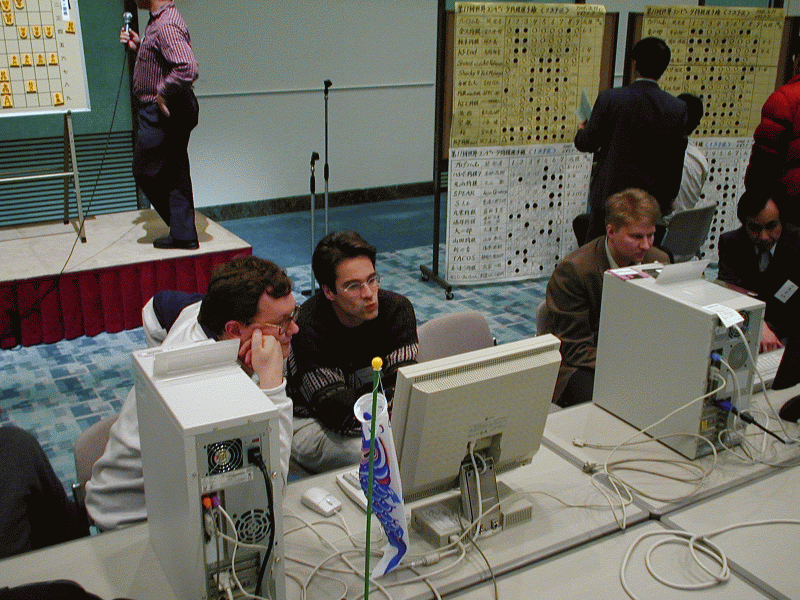
Finland against Holland in Japan: Shocky playing Spear. Martin already knows how's winning.
The first round had almost no surprises, but the tournament really came alive in the second and the third round. Kanazawa Shogi and Kakinoki Shogi lost two games in a row! KCC Shogi showed it was the big favorite to win the title by first beating Kakinoki Shogi in round two and then Kanazawa Shogi in round three. Kanazawa Shogi had serious hardware problems, as the new processor they were using heated up too much, which indirectly caused the program to lose in the second round against Tancho. From that moment on, Kanazawa Shogi played with a big electric fan pointing straight into the PC they were using. This was just enough to play a game without overheating, but it must have been torture to sit and wait for the hardware to hold out or break down. Kakinoki Shogi lost its third round game to Gekizashi and a sensational line-up for the final seemed to be in the making with KCC Shogi, Gekizashi, Sogin, Eisei Meijin and Shocky all starting with three wins. This group was followed by Hyper Shogi, Shotest, Yano Shogi and Suzu no ne with two wins and one loss.
In round 4 KCC Shogi lost surprisingly against Hyper Shogi, but most other games went as expected. Gekizashi beat Shocky and Eisei Meijin lost against Sogin, cutting the group of leaders to two programs. Biggest surprise of the round was the loss of Tancho against Usapyon. Tancho had only one and a half points from four games here and this seemed completely hopeless.
Round 5 and 6 brought bad news for Gekizashi and the two non-Japanese favorites Shotest and Shocky. All three programs lost two games in a row and suddenly the tournament was getting very tight as there were no more undefeated programs. KCC Shogi, Hyper Shogi and Sogin led with 5 wins and one loss, followed by Gekizashi, Kakinoki Shogi, Kanazawa Shogi, Yano Shogi, Ryu no Tamago and Eisei Meijin. Further down the table, Spear had recovered from a terrible 1-3 start (including a loss against KFEnd caused by the same bug that almost lost the game against Aichan earlier). Two wins in row had brought all European programs on the same score, as Shocky and Shotest also had 3 wins and 3 losses.
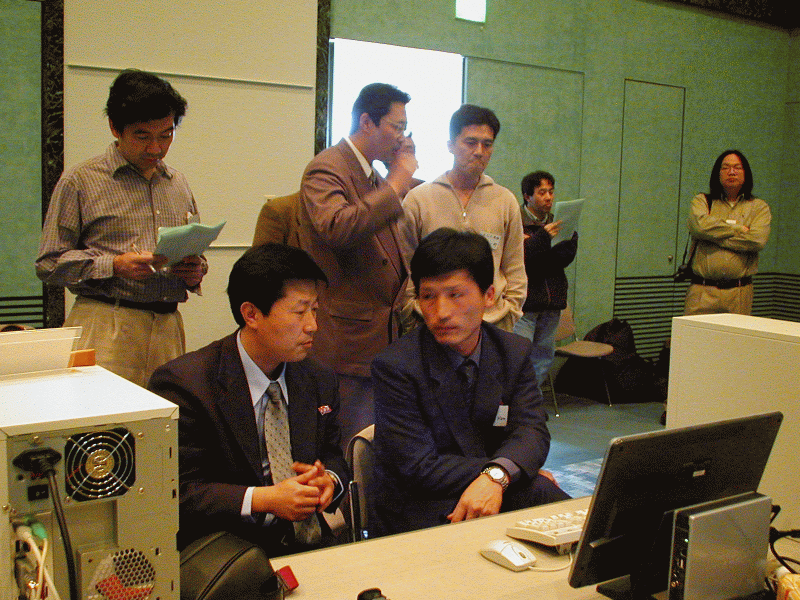
KCC: no problems in the second qualification round.
KCC Shogi also won in round 8, but it was more interesting to see what was happening behind them. Hyper Shogi beat Sogin to qualify for the final. A great achievement by the program that seemed to be struggling at times on the first day. Gekizashi also ended all doubts with a great victory over Kanazawa Shogi. Kakinoki Shogi also qualified with a win over Ryu no Tamago. Four places in the final decided, three places left. With six wins qualification was certain, but it was possible that one or two programs with 5 wins would qualify as well. There were still five programs with a qualification chance: Kanazawa Shogi (5 points), Sogin (5 points), Yano Shogi (5 points), Tancho (amazing recovery and 4 and half points) and Shotest (4 points). Spear was no longer among them with a loss against Takada Shogi. With the number of weak opponents, even 5 points would not be enough for Spear to qualify. Still, the final round was vital for me as well, as a win would secure a seeded place in the second qualification round next year.
The final round paired Kanazawa Shogi against Yano Shogi, Sogin against Tancho and Shotest against Takada Shogi. Kanazawa Shogi beat Yano Shogi and the game Shotest- Takada Shogi was also over quickly with a win by Shotest. A lot of complicated calculations followed with the conclusion that Sogin would qualify whatever the result of the final game. If Sogin would win, Shotest would be the lucky program to qualify with five wins. If Tancho would win, Tancho would qualify. This game was a very long battle and for a long time it looked like Sogin was winning. However, Tancho managed to turn the tables and qualify for the finals from a hopeless position. Tancho has been very close to the finals for years without quite making it, so it was good to see the efforts of Todoroki-san finally being rewarded. As for Spear, it had to play the final game against Shocky. This game looked like it would have slow build-up and I took the opportunity to go to the bathroom (playing by serial cable has its advantages). When I came back I couldn't believe my eyes. Spear was a bishop up without any compensation for Shocky! It turned out that just after I left, Shocky started an attack which lost a silver beyond Shocky's search horizon. To try and save this silver, Shocky sacrificed even more material. After all this (which I had missed completely), the game quieted down. Shocky struggled to get back in the game, but Spear is now strong enough to win against any opponent from such an overwhelming position, so the result was never in doubt. This made it 2-1 in the Spear- Shocky CSA rivalry as Pauli and I now played each other three years in a row. More importantly, I don't have to go through the qualification hell of the first day next year!
No Program Name 1 2 3 4 5 6 7 8 9 Pt SOS SB *1 KCC Shogi 13+ 4+ 5+ 2- 14+ 8+ 7+ 11+ 3+ 8.0 49.0 42.0 *2 Hyper Shogi 7 6+ 10+ 8- 1+ 16+ 14+ 3- 7+ 4+ 7.0 48.5 37.5 *3 Gekizashi 21+ 12+ 4+ 14+ 11- 7- 2+ 5+ 1- 6.0 49.0 31.0 *4 Kakinoki Shogi 18+ 1- 3- 9+ 24+ 15+ 11+ 10+ 2- 6.0 45.5 24.5 *5 Kanazawa Shogi 10+ 6- 1- 24+ 15+ 11+ 14+ 3- 9+ 6.0 44.0 24.5 *6 Tancho under Reiki 2- 5+ 23= 17- 8+ 22+ 15- 9+ 7+ 5.5 40.0 23.0 *7 Sogin 16+ 8+ 12+ 11+ 9- 3+ 1- 2- 6- 5.0 50.5 25.0 8 Shotest 19+ 7- 2+ 16+ 6- 1- 9- 17+ 15+ 5.0 45.5 22.0 9 Yano Shogi 14- 17+ 19+ 4- 7+ 12+ 8+ 6- 5- 5.0 43.5 22.0 10 Ryu no Tamago 5- 2- 13+ 19+ 17+ 16+ 12- 4- 20+ 5.0 43.0 19.0 11 Eisei Meijin 20+ 23+ 24+ 7- 3+ 5- 4- 1- 17+ 5.0 41.5 16.5 12 KFEnd 15+ 3- 7- 13+ 20+ 9- 10+ 14- 18+ 5.0 41.0 21.0 13 SPEAR 1- 18+ 10- 12- 22+ 19+ 16+ 15- 14+ 5.0 39.0 17.0 14 Shocky 9+ 22+ 17+ 3- 1- 2- 5- 12+ 13- 4.0 48.0 16.0 15 Takada Shogi 12- 21+ 16- 23+ 5- 4- 6+ 13+ 8- 4.0 41.5 15.5 16 Suzu no ne 7- 19+ 15+ 8- 2- 10- 13- 20+ 21+ 4.0 40.0 13.0 17 Usapyon 22+ 9- 14- 6+ 10- 24+ 21+ 8- 11- 4.0 36.0 12.0 18 Sekita Shogi 4- 13- 21- 20+ 19- 23+ 24+ 22+ 12- 4.0 30.5 8.5 19 Nazoteki Denki 8- 16- 9- 10- 18+ 13- 22- 23+ 24+ 3.0 33.5 7.5 20 Amano Shogi 11- 24- 22+ 18- 12- 21+ 23+ 16- 10- 3.0 31.5 7.0 21 Ojiro 3- 15- 18+ 22- 23+ 20- 17- 24+ 16- 3.0 30.5 7.5 22 Sakura 17- 14- 20- 21+ 13- 6- 19+ 18- 23- 2.0 33.5 6.0 23 Sakashita Shogi 24= 11- 6= 15- 21- 18- 20- 19- 22+ 2.0 31.0 2.0 24 TACOS 23= 20+ 11- 5- 4- 17- 18- 21- 19- 1.5 36.0 3.0 * KCC Shogi, Hyper Shogi 7, Gekizashi, Kakinoki Shogi, Kanazawa Shogi, Tancho under Reiki and Sogin qualify for the finals.
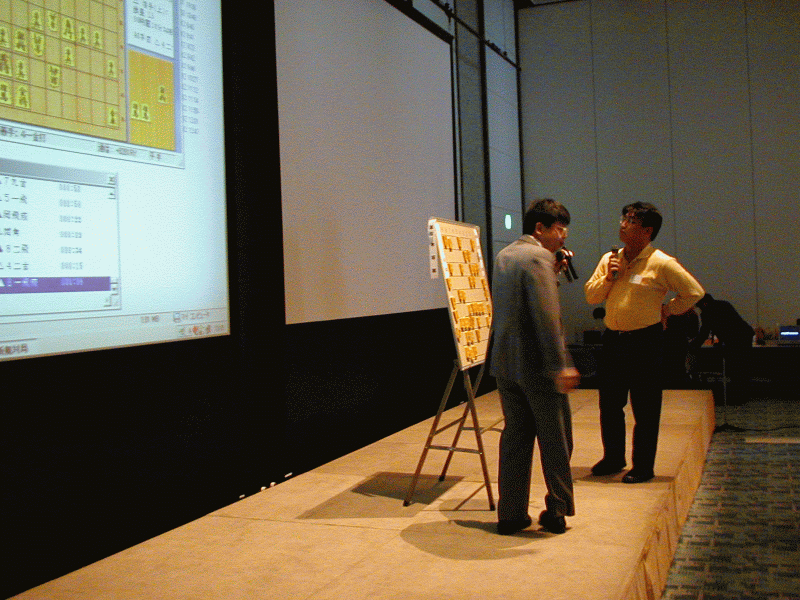
Shogi professional Katsumata (on the left) commenting on the games.
The finals this year promised to be a showdown between IS Shogi, KCC Shogi and maybe YSS. Also, Gekizashi's performance would be watched closely. The first two rounds went almost completely as expected, with IS Shogi and KCC Shogi winning both their games. Kanazawa Shogi also started well. The win over YSS in the second round either indicated that they had managed to solve some of the problems overnight or that YSS was not as strong as expected. Gekizashi found the going a lot tougher in the finals with two losses to start the day. However, losing against IS Shogi and KCC Shogi can't really be called upsets.
In round 3 Gekizashi showed what it can do by beating Kanazawa Shogi for the second day in a row and followed this in round 4 with a win over Kakinoki Shogi. After four rounds the tournament seemed to turn into a two horse race between IS Shogi and KCC Shogi, just as the television crew from Asahi television had hoped. They were followed by Kanazawa Shogi and YSS, but from the way these two played so far it seemed unlikely that they would catch up.
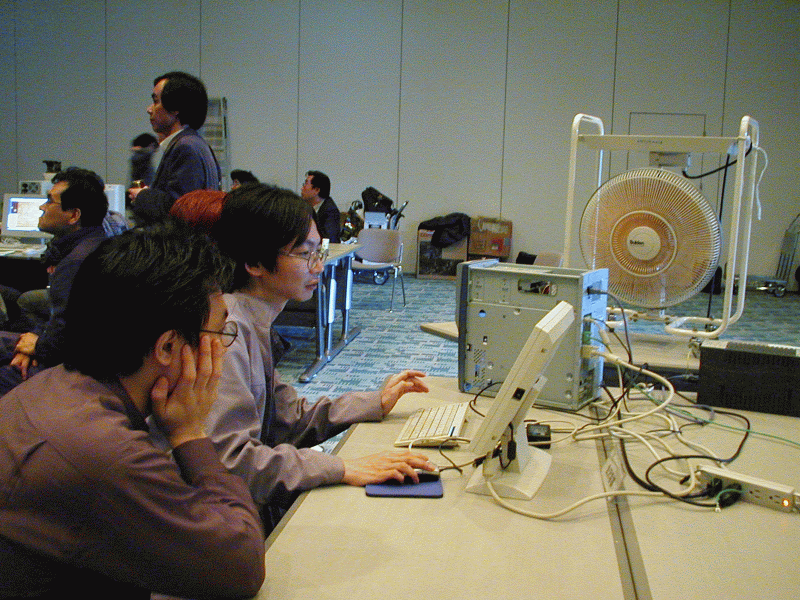
Kanazawa Shogi: back at the top as usual.
Round 6 more or less ended all hopes for Kanazawa Shogi to get another CSA crown as IS Shogi beat Kanazawa Shogi to make it six wins in a row. YSS lost against KCC Shogi, so now it was really between IS Shogi and KCC Shogi for the championship with IS Shogi having the advantage of being undefeated. This advantage was almost lost in round 7 as IS Shogi came very close to losing against Kawabata Shogi. So far, Kawabata Shogi hadn't made any impression at all with its two wins coming against Sogin and Tancho. However, the game against IS Shogi was different. At some point there was even a forced win for Kawabata Shogi, but the program didn't find it. IS Shogi desperately defended and when Kawabata Shogi got into time trouble, things slowly started to turn around. In the end IS Shogi won the game, but Kawabata Shogi showed in this game that the program is stronger than the number of wins indicated.
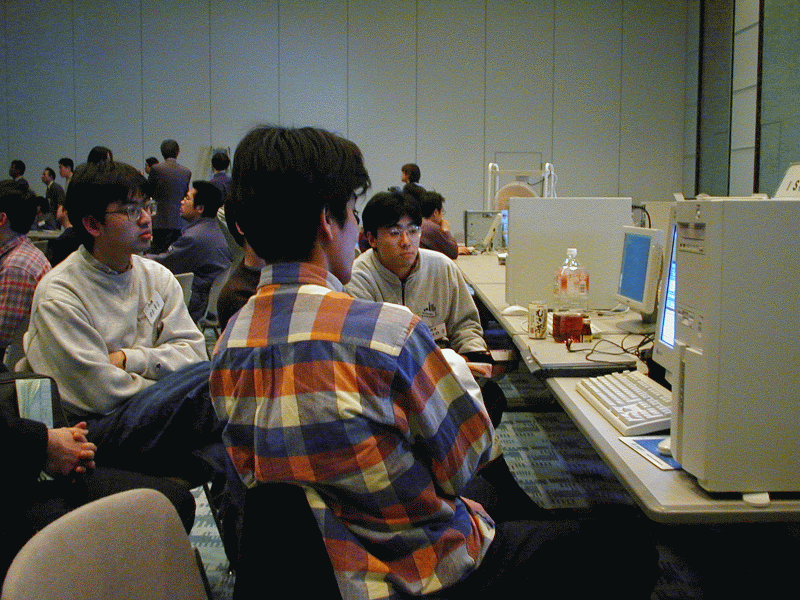
The glorious winners. From left to right: Kishimoto, Goto and Tanase.
With this game the tournament was not over yet. Gekizashi showed that it still has some instability with a shocking defeat against Tancho. This would actually be Tancho's only win in the finals and also mean that Gekizashi didn't get third place, dropping back to the qualification rounds next year.
The final round had no surprises as all top programs won. IS Shogi therefore won the title with a perfect score, but its final round win against YSS will be the start of some discussion on the rules for computer shogi. After about 50 moves, both programs didn't find a way to continue the game and started moving around pieces aimlessly. In shogi, there is a rule for a draw after repetition of positions (four times the same position ends the game), but there is no 50 move rule as in chess. Both IS Shogi and YSS had code for avoiding the repetition of positions, but found enough moves to do nothing for a long time but making sure to avoid a draw. This situation lasted for about 150 moves and the game became very painful to watch and an embarrassment for the programmers. Finally, IS Shogi's abilities for thinking in the time of the opponent gave it a huge time advantage and when YSS had almost no time left, the game finally was opened. Of course, IS Shogi had no problem beating a time crippled opponent after that. In the end YSS was mated at about the same time it ran out of time. It seems that computer shogi also needs a 50 move rule to avoid these types of games.
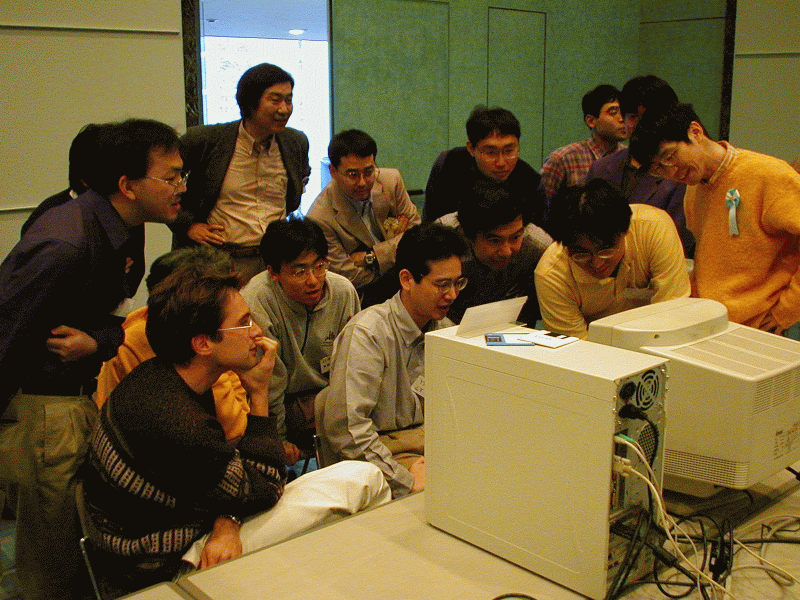
IS Shogi vs. YSS: Finally something is happening (or will we be disappointed again?).
No Program Name 1 2 3 4 5 6 7 8 9 Pt SB 1 IS Shogi 9+ 4+ 6+ 10+ 8+ 2+ 7+ 3+ 5+ 9 36 2 Kanazawa Shogi 8+ 5+ 4- 7+ 3+ 1- 10+ 9+ 6+ 7 23 3 KCC Shogi 4+ 6+ 10+ 9+ 2- 5+ 8+ 1- 7+ 7 22 4 Gekizashi 3- 1- 2+ 6+ 5+ 7+ 9+ 10- 8+ 6 22 5 YSS 11 10+ 2- 9+ 8+ 4- 3- 6+ 7+ 1- 5 11 6 Kakinoki Shogi 7+ 3- 1- 4- 9+ 10+ 5- 8+ 2- 4 7 7 Kawabata Shogi 6- 9+ 8- 2- 10+ 4- 1- 5- 3- 2 3 8 Hyper Shogi 7 2- 10+ 7+ 5- 1- 9- 3- 6- 4- 2 3 9 Sogin 1- 7- 5- 3- 6- 8+ 4- 2- 10+ 2 3 10 Tancho under Reiki 5- 8- 3- 1- 7- 6- 2- 4+ 9- 1 6
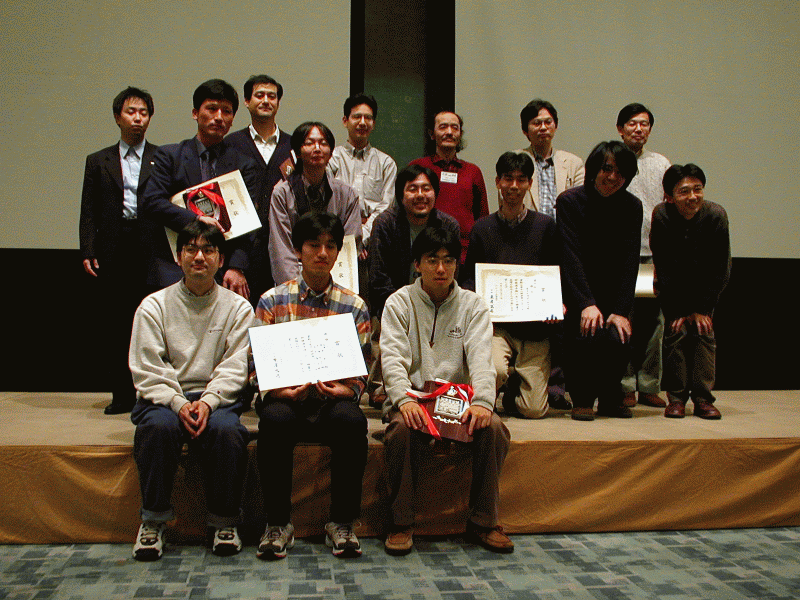
The finalists lined up.
Another observation is that computer shogi is becoming more and more a team effort. Improving different parts of a shogi program seems to be too complicated to do by one person. The first four programs in this tournament all were developed by a team. Most impressive is of course the manpower that was put into KCC Shogi, but it seems that winning the CSA tournament on your own is almost impossible. Maybe it is time to think about combining the skills of the programmers from Europe (Jeff, Pauli and me) and create EURO Shogi. This might be the only way to break through the Asian supremacy.
Black: Kanazawa Shogi White: KCC Shogi 11th CSA Tournament Round 5 March 12th 2001 1.P7g-7f 2.P8c-8d 3.S7i-7h 4.P3c-3d 5.P6g-6f 6.S7a-6b 7.S7h-7g 8.P5c-5d 9.P5g-5f 10.S3a-4b 11.G6i-7h 12.G4a-3b 13.S3i-4h 14.K5a-4a 15.K5i-6i 16.G6a-5b 17.G4i-5h 18.S4b-3c 19.B8h-7i 20.B2b-3a 21.G5h-6g 22.P4c-4d 23.B7i-6h 24.P7c-7d 25.K6i-7i 26.G5b-4c 27.S4h-5g 28.S6b-7c 29.P2g-2f 30.P7d-7e 31.P7fx7e 32.B3ax7e 33.K7i-8h 34.P8d-8e 335.S5g-4 36.K4a-3a 37.P5f-5e 38.P5dx5e 39.R2h-5h 40.B7e-6d 41.S4fx5e 42.R8b-5b 43.P*5d 44.B6d-4b 45.P3g-3f 46.P*7e 47.N2i-3g 48.S7c-6d 49.S5ex6d 50.B4bx6d 51.S*5c 52.G4cx5c 53.P5dx5c+ 54.R5b-8b 55.N3g-2e 56.S*6i 57.N2ex3c+ 58.N2ax3c 59.R5h-1h 60.N*5e 61.G6g-5g 62.P*5f 63.G5g-5h 64.S6ix5h+ 65.R1hx5h 66.S*6i 67.B6h-4f 68.S6ix5h= 69.S*4c 70.N5e-6g+ 71.S*4b 72.G3bx4b 73.S4cx4b+ 74.R8bx4b 75.+P5cx4b 76.B6dx4b 77.R*7a 78.K3a-3b 79.G*7i 80.+N6gx7h 81.G7ix7h 82.S*6i 83.G*6h 84.S6ix7h+ 85.G6hx7h 86.G*6g 87.P*7i 88.G6gx7h 89.P7ix7h 90.G*6g 91.G*7i 92.R*5a 93.R7ax5a+ 94.B4bx5a 95.R*8b 96.G*4b 97.R8bx8a+ 98.G*4a 99.N*5d 100.G4b-5b 101.B4fx9a+ 102.P5f-5g+ 103.P9g-9f 104.S*6h 105.S7gx6h 106.+P5gx6h 107.S*4b 108.G6gx7h 109.K8h-9g 110.G4ax4b 111.S*2a 112.K3b-3a 113.N5dx4b+ 114.K3ax4b 115.G*3b 116.K4b-4c 117.N*5e 118.K4c-5d 119.+R8ax5a 120.G5bx5a 121.G7ix7h 122.S5hx4g+ 123.B*5f 124.S*7f 125.N5ex6c+ 126.S*8f 127.P8gx8f 128.R*5g 129.S*6g 130.R5gx5f+ 131.+B9a-6d 132.K5d-4e 133.S6gx5f 134.K4ex5f 135.R*5c 136.K5f-4e 137.G*4f 138.+S4gx4f 139.R5c-5e+140.K4ex3f 141.+R5ex4f 142.K3f-2g 143.+R4f-3g Resigns Black: IS Shogi White: Kanazawa Shogi 11th CSA Tournament Round 6 March 12th 2001 1.P7g-7f 2.P3c-3d 3.P6g-6f 4.K5a-4b 5.G4i-5h 6.K4b-3b 7.S3i-4h 8.S7a-6b 9.G6i-7h 10.P8c-8d 11.K5i-6i 12.P9c-9d 13.S7i-6h 14.G6a-5b 15.P3g-3f 16.B2b-3c 17.P2g-2f 18.P5c-5d 19.P4g-4f 20.K3b-2b 21.S4h-4g 22.G4a-3b 23.N2i-3g 24.B3c-4b 25.G5h-6g 26.S6b-5c 27.P1g-1f 28.L9a-9c 29.P1f-1e 30.P6c-6d 31.P6f-6e 32.B4b-3c 33.B8hx3c+ 34.N2ax3c 335.P6ex6 36.S5cx6d 37.G6g-7g 38.G5b-5c 39.P*6e 40.S6dx6e 41.B*7a 42.R8b-5b 43.B7ax5c+ 44.R5bx5c 45.G*6d 46.R5c-5a 47.G6dx6e 48.B*9b 49.S4g-5f 50.B9bx6e 51.S5fx6e 52.B*4g 53.K6i-7i 54.B4gx6e+ 55.P3f-3e 56.+B6e-4g 57.P3ex3d 58.G*6i 59.K7i-8h 60.+B4gx3g 61.R2h-1h 62.N*8e 63.P3dx3c+ 64.G3bx3c 65.N*2e 66.G3c-3b 67.G7g-6g 68.P2c-2d 69.P1e-1d 70.P1cx1d 71.S*1c 72.L1ax1c 73.N2ex1c+ 74.K2b-3c 75.L*3i 76.P*3f 77.L3ix3g 78.P3fx3g+ 79.P*3d 80.K3cx3d 81.B*1b 82.K3d-3c 83.+N1cx1d 84.L*6b 85.+N1dx2d 86.K3c-4b 87.P*6f 88.+P3g-4g 89.B1b-4e+ 90.P*1g 91.R1hx1g 92.+P4g-5h 93.P*3c 94.G3b-2b 95.S6h-7i 96.S*4d 97.+B4e-3d 98.P*6e 99.P6fx6e 100.P*3b 101.B*2e 102.S*5b 103.P3cx3b+ 104.S3ax3b 105.B2ex5h 106.G6ix7i 107.G7hx7i 108.P*3c 109.+B3d-2e 110.S*5e 111.P7f-7e 112.P*6f 113.G6g-7f 114.S5ex4f 115.P8g-8f 116.P*1f 117.R1g-2g 118.N8ex9g+ 119.K8hx9g 120.P*2c 121.+N2d-1d122.P9d-9e 123.K9g-8h 124.P9e-9f 125.P*9h 126.S4d-4e 127.P*3e 128.S4f-5e 129.G7i-6h 130.S5e-4d 131.R2g-4g 132.P5d-5e 133.N*3f 134.S4ex3f 135.+B2ex3f 136.N*5c 137.G6h-7h 138.N5cx6e 139.G7fx6f 140.P8d-8e 141.B5hx8e 142.P*8d 143.B8e-7f 144.P1f-1g+ 145.G6f-6g 146.+P1g-2h 147.P*6f 148.+P2hx1i 149.P6fx6e 150.S5b-5c 151.P*4e 152.S4dx4e 153.R4gx4e 154.P7c-7d 155.S*6f 156.L*4d 157.R4ex5e 158.P*5d 159.R5e-5f 160.P7dx7e 161.S6fx7e 162.P*1c 163.+N1d-1e 164.N8a-7c 165.S*7d 166.N7cx6e 167.P*6c 168.P*7g 169.G7h-7i 170.L6bx6c 171.S7dx6c+ 172.P*6d 173.N*7d 174.P8d-8e 175.P8fx8e 176.L4d-4h+ 177.N7d-6b+ 178.S5cx6b 179.+S6cx6b 180.R5a-5c 181.S7ex6d 182.S3b-4a 183.S6dx5c+ 184.K4b-3b 185.R*1a 186.P9f-9g+ 187.P9hx9g 188.L9cx9g+ 189.L9ix9g 190.G2b-2a 191.+S5cx4c 192.K3b-2b 193.R1ax1c+ 194.K2bx1c 195.L*1d 196.K1c-2b 197.G*1b 198.G2ax1b 199.L1dx1b+ 200.K2bx1b 201.P*1c 202.K1bx1c 203.L*1d 204.K1c-2b 205.G*1b 206.K2b-3a 207.S*2b Resigns Black: IS Shogi White: KCC Shogi 11th CSA Tournament Round 8 March 12th 2001 1.P7g-7f 2.P8c-8d 3.S7i-6h 4.P3c-3d 5.S6h-7g 6.S7a-6b 7.S3i-4h 8.S3a-4b 9.G6i-7h 10.G4a-3b 11.P2g-2f 12.P5c-5d 13.P2f-2e 14.S4b-3c 15.K5i-6i 16.B2b-3a 17.G4i-5h 18.K5a-4a 19.P4g-4f 20.G6a-5b 21.S4h-4g 22.P4c-4d 23.P6g-6f 24.B3a-4b 25.B8h-7i 26.P7c-7d 27.B7i-6h 28.N8a-7c 29.K6i-7i 30.K4a-3a 31.B6h-5i 32.P8d-8e 33.P3g-3f 34.G5b-4c 35.B5i-2f 36.K3a-2b 37.N2i-3g 38.B4b-6d 39.K7i-8h 40.P5d-5e 41.G5h-6g 42.P9c-9d 43.L1i-1h 44.P9d-9e 45.R2h-2i 46.R8b-8a 47.R2i-5i 48.R8a-5a 49.N3g-4e 50.S3c-4b 51.R5i-1i 52.G4c-5d 53.P6f-6e 54.N7cx6e 55.S7g-6f 56.B6d-7c 57.S6fx6e 58.G5dx6e 59.N8i-7g 60.G6e-6d 61.B2fx4d 62.N2a-3c 63.B4d-2f 64.N3cx4e 65.P4fx4e 66.P7d-7e 67.P*6e 68.G6d-7d 69.N*5d 70.R5ax5d 71.N*4f 72.R5d-5b 73.N4fx3d 74.K2b-2a 75.N3dx4b+ 76.R5bx4b 77.S*5c 78.S6bx5c 79.B2fx5c+ 80.P5e-5f 81.S*3c 82.S*3a 83.+B5cx4b 84.S3ax4b 85.S3cx4b+ 86.G3bx4b 87.R*7b 88.S*3a 89.P2e-2d 90.P7ex7f 91.P2dx2c+ 92.P7fx7g+ 93.G7hx7g 94.S*6b 95.S*3c 96.G4bx3c 97.+P2cx3c 98.P*3b 99.P*2b 100.S3ax2b 101.R1i-2i 102.P3bx3c 103.G*2c 104.P*2h 105.R7bx7c+ 106.S2bx2c 107.+R7cx6b 108.S*3b 109.R2ix2h 110.P*2d 111.+R6b-7a 112.G*4a 113.+R7ax7d 114.N*5e 115.S4gx5f 116.N5ex6g= 117.S5fx6g 118.N*5e 119.S6g-7h 120.B*3i 121.B*1i 122.B3ix5g+ 123.S*6f 124.+B5g-5f 125.N*3e 126.G*6g 127.P*2b 128.K2ax2b 129.N3ex2c+ 130.S3bx2c 131.S*4d 132.N*6d 133.+R7d-7b 134.P*4b 135.S6fx5e 136.G6gx7h 137.G7gx7h 138.N*7f 139.K8h-7g 140.N*5b 141.N*1e 142.S2c-3d 143.R2hx2d 144.S*2c 145.R2dx2c+ 146.S3dx2c 147.N1ex2c+ 148.K2bx2c 149.G*2d 150.K2cx2d 151.S4d-3e 152.K2d-2e 153.S*2f 154.K2ex3f 155.G*3g 156.K3fx4e 157.S*4f 158.+B5fx4f 159.G3gx4f Resigns